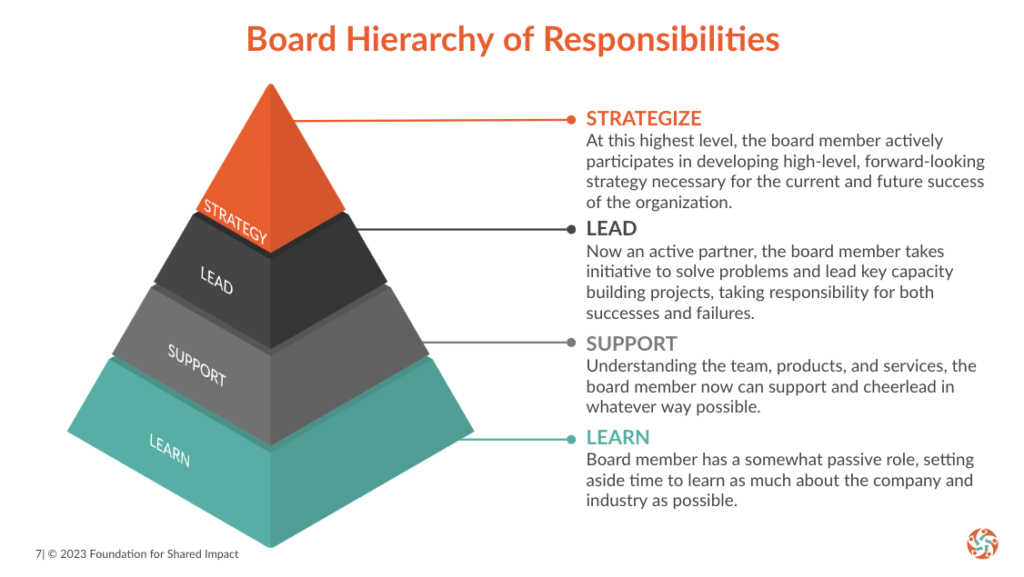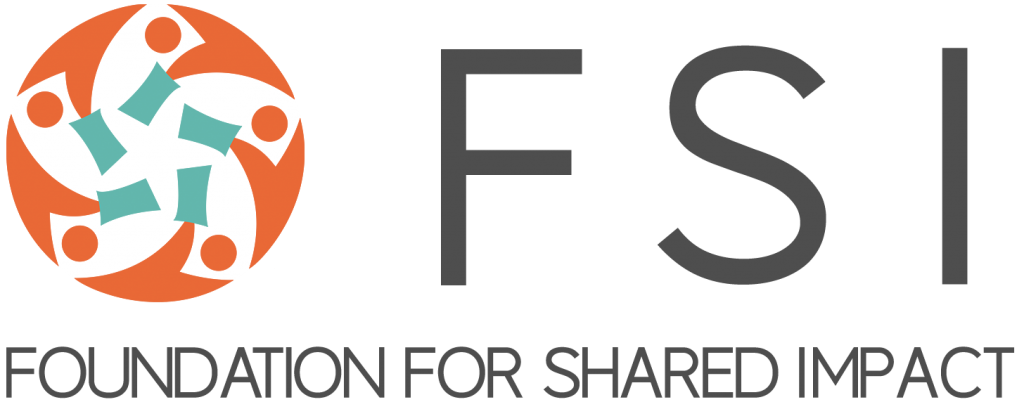A huge thank you to Juliette Deiss for your contributions towards developing this handbook. Your time and commitment to this project is truly appreciated.
If you would like a downloadable, PDF version of this guide please click here.
Why Have a Board of Directors?
While managers and employees of an organization are responsible for the day-to-day operations of a social impact organization, the board of directors, also known as the executive board, is responsible for high-level planning and oversight. It is therefore important to choose board members based on their areas of expertise that complement the needs of the organization.
Board members can assist with strategic planning such as growth plans and executive transitions. As part of their governance responsibilities, board members provide risk oversight and identify when an organization needs to pivot from its original action plan. They also guide the organization on legal and compliance matters. Board members are not involved in day-to-day operations. Rather, they stay informed on the work progress and ensure that the organization’s work doesn’t deviate from its vision and mission.
Additionally, board members leverage their own networks to advocate and fundraise for the organization. They can also serve as mentors for the employees and managers of the organization.
To recap, these are the functions a board of directors serves for your organization:
- Strategic Planning
- Risk Oversight
- Accountability
- Networking
- Advocacy
- Fundraising
- Subject Matter Expertise
How to Recruit Board Members
Chances are that you already know someone in your network who is a suitable candidate for your board of directors. They can be a dedicated, long-time skills-based volunteer who is passionate about your organization’s cause, or they can be an existing stakeholder whose knowledge and expertise is beneficial to your organization’s growth.
Foundation for Shared Impact (FSI)’s Community Connections Program offers a board introduction service that connects skilled professionals who have taken FSI’s Board Director Training with mission-aligned social impact organizations looking for board members or advisors.
Alternatively, you can post a job description on LinkedIn or recruitment platforms such as Recruit4Good. Going through the exercise of writing a job description is beneficial to you, because it forces you to articulate your organization’s vision and mission, and to think about the challenges you want your board to address for your organization. A sample job description for the purposes of recruitment can be found in Appendix I.

Depending on your organization’s needs, you may be looking for a specific set of skills including:
Accounting
Audit
Finance and Investment
Legal
Industry Regulation
(e.g., health, education)
Human Resources Talent Management
Data and Analytics
(including impact measurement)
Risk and Crisis Management
Volunteer Management
Branding, Marketing, Communications, Public Relations
Governance
(including familiarity with the Code of Governance for Charities and IPCs (“Code”) and applicable laws and regulations)
Technology, Digitalisation, and Cybersecurity
Donor Management, Fundraising
Access our guide for tips on how to identify potential board members for your organization here.
Remuneration
The legal and ownership structures of the organization are a factor for director remuneration. So those who agree to take a board position should take some time to understand the rules that are specific to their organization and its relevant jurisdiction(s). For example, directors of tax-exempt charities in Hong Kong are disallowed from receiving any type of payment or remuneration for their work as directors without prior approval from the HK Inland Revenue Department.
This can also be the case for social enterprises that operate to generate surpluses for their goods and/or services, not profits. However, the remuneration, if any, can be mutually agreed upon by the social enterprise and the director.
How to Engage with your Board of Directors
A board of directors is vital in supervising the management of your organization by representing and meeting the interests of your key stakeholders. While it varies from one organization to another, a board of directors has several responsibilities that include:
- Developing a mission statement – to clarify your organization’s goals and intentions
- Selecting and supporting the chief executive – recruiting the most qualified candidate and ensuring they have adequate support to fulfill your organization’s mission
- Ensuring adequate financial resources and providing financial oversight – includes developing an annual budget
Your board of directors should also consist of the following roles:
Chairperson
Leading the board and its meetings
Vice chair
Second in command, assists the chairperson
Secretary
Records meetings and is responsible for communication between board members
Treasurer
Oversees the organization’s finances, budget, and property
There are several qualities to look out for when choosing your board members. This includes their experience as leaders and decision-makers, enthusiasm for your company’s mission and goals, and willingness to commit time and effort to learn about your organization’s operations and challenges. The latter is important so your board members can positively contribute to your organization.
Access our step-by-step guide for recruiting members for a diverse and inclusive board here.

Why it is Important to Engage with Your Board of Directors
Your board members are an integral part of your management, and effective engagement with them will ensure that they are informed in a timely manner, in order to provide guidance and make strategic decisions based on current information. You should define the roles and responsibilities of your board members based on their expertise and communicate them with the individuals. Delegating and communicating a variety of specific roles and responsibilities that are essential to running your organization will create a board that can function in a complementary and holistic manner.
How to Engage
1. Weekly updates
Send a weekly email to your board of directors to summarize your organization’s updates and upcoming activities. Make sure to list any actions that you want your board of directors to take, if any.
2. Regular meetings
It is important to regularly meet with your board members to discuss and plan your organization’s future. To make such meetings effective and productive, consider the following good practices.
Agenda
Create an agenda to structure the meetings. Have a clear outline of what needs to be discussed and what are the expected outcomes of the meeting. The agenda should:
- Place the most important items at the top – focus on pertinent issues that require the board’s attention
- Set time limits for agenda items – be realistic, but also make use of the time wisely
- Separate strategic and operational items
- Indicate which items are informative and which ones require discussion
- Implement a consent agenda – consolidate routine items for the board to pass with a single vote
Before the meeting
- Share the draft agenda with the appropriate party(ies) to request input and verify if additional items need to be included.
- Send the meeting agenda and all relevant attachments (including reports and documents) at least one week prior to the meeting and request that board members familiarize themselves with the agenda items.
- Send emails reminding board members of the upcoming meetings.
- Ask your board members whether they prefer to meet virtually or in person. For in-person meetings, consider a collaborative layout for the meeting room, such as arranging the tables in a U-shape to facilitate discussion.
During the meeting
- Start and end meetings on time. This is why preparing and sharing the agenda ahead of time is important. Also be sure to stick to the agenda.
- Encourage all members to speak and ask questions. Be sure to allot time in the agenda for this session.
- Focus on making decisions rather than giving updates, especially when board members can read through documents before the meeting.
After the meeting
Evaluate the meeting. Was it productive? Did you get through all the items on the agenda? Was everyone able to contribute towards the discussion and decision-making process? Assess the performance of the meeting and the involvement of the board members, and adjust as needed to improve the productivity of future meetings.
3. Define communication methods and frequency
Make it clear to your board members how you plan to contact them and how they should contact you. Whether this be through email, message platforms, phone calls, or face-to-face, it is critical to establish an effective medium of exchange to avoid miscommunication.
Define how often this communication will occur. Will you send weekly/bi-weekly/monthly emails? How often will board meetings occur?
4. Inviting board members to your organization’s events
Inviting board members to your company’s functions, such as fundraising and networking events, allows them to connect with your organization’s vision, mission, and impact by meeting your team, partners and collaborators, beneficiaries, funders, etc. It equally provides board members with a more casual and social environment where they can interact as friends rather than colleagues, all whilst learning more about your role in the day-to-day activities of the company.
5. Build trust and transparency
Board assessments can be conducted at a time and frequency suitable to the organization. However, conducting an assessment annually, after significant events or milestones, and during board transitions is the most optimal. Board assessments can also provide a structured process for open and constructive dialogue during challenging situations.
Periodic Board Assessment and Review
To ensure your board is functioning efficiently and effectively, consider asking your board members to fill out a Board Self-Evaluation Questionnaire for assessment purposes. Not only can regular self-assessments enable boards to evaluate their performance, but they can also enhance their effectiveness, identify skills gaps, improve board dynamics, and ensure compliance with existing and new governance requirements.
Board assessments can be conducted at a time and frequency suitable to the organization. However, conducting an assessment annually, after significant events or milestones, and during board transitions is the most optimal. Board assessments can also provide a structured process for open and constructive dialogue during challenging situations.
